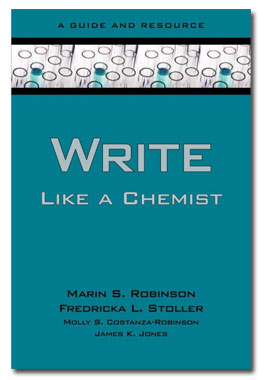Writing like a chemist may seem as incongruous as singing like a bioengineer or dancing like a paleontologist. Yet Marin Robinson and Fredricka Stoller are convinced they are on to something important.
“At more advanced levels of academic study, students need to move away from general ways of communicating to discipline-specific ways of writing,” said Stoller, an English professor at NAU. “Our one-of-a-kind book represents a resource that can be used by chemistry faculty to help their students develop specific writing skills. What’s unique about the book is that chemists and applied linguists had the opportunity to collaborate.”
The two are part of a four-person team to publish Write Like a Chemist: A Guide and Resource (Oxford University Press, 2008).
Stoller and Robinson, a professor of chemistry and biochemistry at NAU, worked with Molly Costanza-Robinson, assistant professor of environmental chemistry at Middlebury College in Vermont, and James K. Jones, a graduate teaching assistant, to create Write Like a Chemist as a guide to chemistry-specific writing.
Written with National Science Foundation support and used in chemistry courses nationwide, it offers a structured approach to writing instruction that targets four chemistry genres: the journal article, conference abstract, scientific poster and research proposal.
Chemistry students, post-docs, faculty and other professionals interested in perfecting their disciplinary writing will find it useful, Robinson said.
Users of the book will learn to write through a host of exercises, ranging in difficulty from correcting single words and sentences to writing professional-quality papers, abstracts, posters and proposals.
The book’s read-analyze-write approach teaches students to analyze what they read and then write, paying attention to audience, organization, writing conventions, grammar and science content, thereby turning the complex process of writing into graduated, achievable tasks.
Concise writing and organizational skills are stressed throughout, and “move structures” teach students conventional ways to present their work. The book includes more than 350 excerpts from American Chemical Society journal articles and conference abstracts, in addition to successful NSF proposals.



